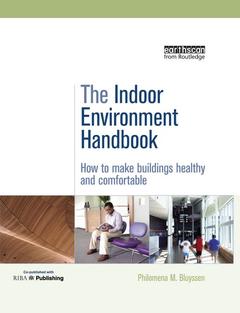Description
The Indoor Environment Handbook
How to Make Buildings Healthy and Comfortable
Author: Bluyssen Philomena
Language: English
Subjects for The Indoor Environment Handbook:
Keywords
Indoor Environment; Indoor Environmental Parameters; environmental; Indoor Air Quality; parameters; Thermal Comfort; thermal; Vice Versa; comfort; Reverberation Time; air; Sound Pressure Level; quality; Perceived Air Quality; endocrine; IEQ; system; Part III; external; External Stress Factors; stress; VOCs; Multiple Chemical Sensitivity; De Dear; Indoor Chemistry; Chronic; Asthma Related Health Outcomes; SBS; Light Therapy; Te Ch; European Audit Project; Spinal Cord; RF; Hope Project; National Academy
Publication date: 11-2015
· 18.9x24.6 cm · Paperback
Publication date: 10-2009
290 p. · 18.9x24.6 cm · Hardback
Description
/li>Contents
/li>Readership
/li>Biography
/li>
Winner of the Choice Outstanding Academic Titles of 2010 award.
Ensuring that buildings are healthy and comfortable for their occupants is a primary concern of all architects and building engineers. This highly practical handbook will help make that process more efficient and effective.
It begins with a guide to how the human body and senses react to different indoor environmental conditions, together with basic information on the parameters of the indoor environment and problems that can occur. It then moves on to give a background to the development of the study and control of the indoor environment, examining the main considerations (including thermal, lighting, indoor air and sound-related aspects) for a healthy and comfortable indoor environment and discussing the drivers for change in the field. The final section presents a new approach towards health and comfort in the indoor environment, where meeting the wishes and demands of the occupants with a holistic strategy becomes the over-riding priority. The book is filled with useful facts, figures and analysis, and practical methods that designers who are keen to assess and improve the user experience of their buildings will find invaluable.
Why this Book? How to Read This Book Part I: Humans and the Indoor Environment 1. Health and Comfort & Indoor Environmental Control 2. Human Reception and Perception 3. The Indoor Environment Part II: Health and Comfort in the Indoor Environment 4. Past, Present and Future of Health and Comfort in the Indoor Environment 5. Defining Health and Comfort in the Indoor Environment 6. Drivers of Health and Comfort in the Indoor Environment Part III: Management of the Indoor Environment 7. An Interactive and Sustainable Approach 8. The Top Down Approach 9. The Individual Interactions Summary and Conclusions Annexes: A. TOBUS B. Sensory Evaluation by the Human Nose C. Current Standards and Regulations D. Some Attributes and Factors
After more than two decades working for TNO, Philomena M. Bluyssen started as a full Professor of Indoor Environment at the Delft University of Technology in 2012. She has written more than 170 publications.




